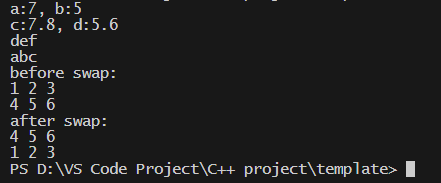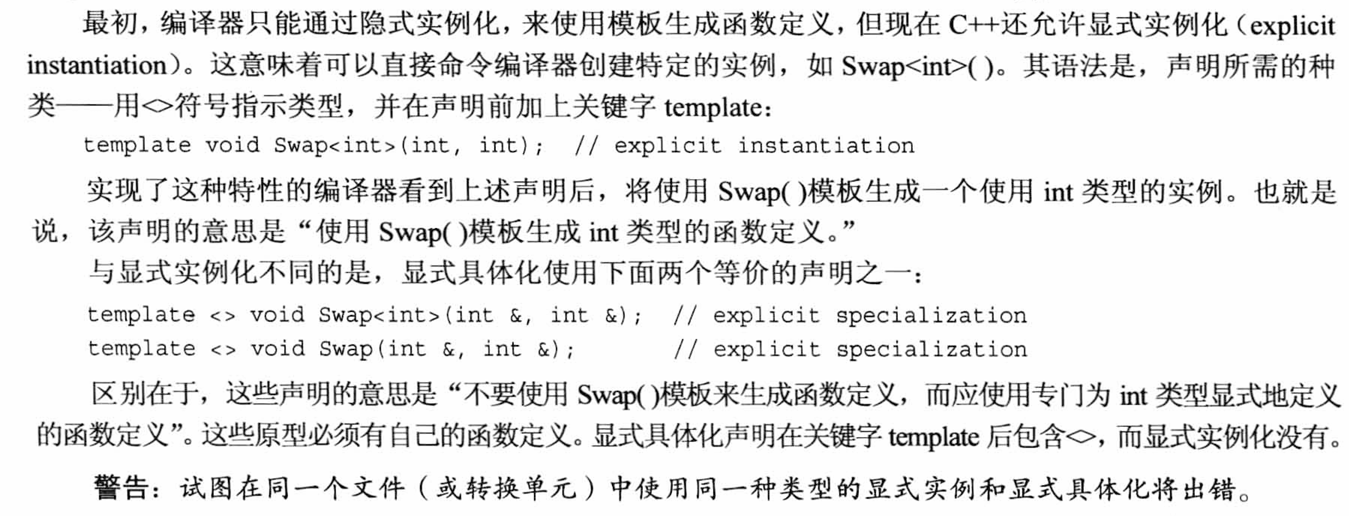C++模板
C++模板#
C++是一个面向对象编程的语言,提供了类的继承和组合机制,虽然在层次结构上很简单,但使用起来非常糟糕。C++使用关键字template,告诉编译器声明的类或者对象是一个模板。模板不是像继承和组合那样重用目标代码,而是重用源代码。容器不再包含名为 Object 的泛型基类,而是包含未指定的参数。与C语言中的宏定义有点类似,编译器可以将参数替换所需要的类型,使用模板比使用宏更加清晰和简单。

参考:Thinking in C++, Chapter 16
函数模板#
函数模板,顾名思义就是一个模板,用于指定实现函数参数的不同类型的一种模板。语法:template <typename/class T> void func(T&)。
template <typename T>
void func(T&); //声明
template <typename T> //定义
void func(T& t)
{
....
}
int main()
{
...
int a = 5;
func(a);
...
}
类模板#
类模板就是将模板用于类,举个Stack类的例子,首先在stack.h中声明一个类模板,注意由于模板不是函数,不能单独编译。模板必须与特定的模板实例化请求一起使用。因此,最简单的方式就是将所有模板信息放在一个头文件中,并在要使用该模板的文件中包含该头文件。在stack类这个例子中就只有stack.h,而没有stack.cpp文件
定义和使用类模板
template <typename T> //声明
class Stack
{
private:
T *base;
...
public:
Stack();
}
//定义类模板中的函数,Stack::Stack改为Stack<T>::Stack
template <typename T>
Stack<T>::Stack()
{
...
}
//调用该模板
int main()
{
...
Stack<int> s; //需要加<int>
...
}
stack.h:
//stack.h
#ifndef _STACK_H
#define _STACK_H
const int size = 128;
//类模板
template <typename T> //C++11,用typename T代替class T
class Stack
{
private:
int top;
T *base; //栈底指针
int size; //栈中元素个数
public:
Stack(int size);
bool push(T e);
bool pop(T& e);
void peek();
bool isEmpty();
void show(); //展示栈中所有元素
};
template <typename T>
Stack<T>::Stack(int size)
{
this->base = new T[size]; //dynamic memory allocation
//new如果分配内存失败则会抛出异常
this->top = 0; //指向栈顶的元素的下一个位置
this->size = size;
}
//栈满没有考虑扩容的问题
template <typename T>
bool Stack<T>::push(T e)
{
if(this->top >= this->size)
return false; //栈满
this->base[top++] = e; //入栈,栈顶指针+1
return true;
}
template <typename T>
bool Stack<T>::pop(T& e)
{
if(this->top == 0) //栈空
return false;
e = this->base[--top]; //通过e传递出去
return true;
}
//0 1 2 3
template <typename T>
bool Stack<T>::isEmpty()
{
return (this->top == 0);
}
#endif
main.cpp:
#include <iostream>
#include "stack.h"
struct customer
{
char fullname[35];
double payment;
};
int main()
{
using namespace std;
Stack<customer> s(128); //栈大小:128个customer
customer c1 = {"c1", 23.5};
customer c2 = {"c2", 39.3};
customer c3 = {"c3", 14.7};
customer c4; //接收出栈的元素
//元素入栈
if(s.push(c1)) cout << "c1入栈..\n";
s.push(c2);
s.push(c3);
if(s.pop(c4)) cout << "c4出栈..\n";
cout << "pop(c4): " << c4.fullname << ", " << c4.payment << endl;
return 0;
}
参考资料:C++ Primer Plus(第六版) p569
模板重载#
模板语法:template <typename/class T> void func(T &, T &);
其中typename和class都可以表示类或者原始类型(int、double、char等),后面是函数函数返回类型void,函数名func,参数类型为T&,编译器会将T&转为所需要的类型,如int&、double&。
#include <iostream>
using namespace std;
/****************************/
//template overloading
template <typename T>
void Swap(T &a, T &b);
template <typename T>
void Swap(T *a, T *b, int);
/****************************/
int main()
{
int a = 5, b = 7;
Swap(a, b);
cout << "a:" << a << ", b:" << b <<endl;
double c = 5.6, d = 7.8;
Swap(c, d);
cout << "c:" << c << ", d:" << d <<endl;
string s("abc");
string t("def");
Swap(s, t);
cout << s << endl;
cout << t << endl;
const int n = 3;
int e[n] = {1,2,3};
int f[n] = {4,5,6};
cout << "before swap:" << endl;
for(int i = 0; i < n; i++)
cout << e[i] << " ";
cout << endl;
for(int i = 0; i < n; i++)
cout << f[i] << " ";
Swap(e, f, n);
cout << endl;
cout << "after swap:" << endl;
for(int i = 0; i < n; i++)
cout << e[i] << " ";
cout << endl;
for(int i = 0; i < n; i++)
cout << f[i] << " ";
return 0;
}
//template overloading definition
template <class T>
void Swap(T &a, T &b){
T temp;
temp = a;
a = b;
b = temp;
}
//template overloading definition
template <class T>
void Swap(T *a, T *b, int n){
for(int i = 0; i < n; i++){
T temp;
temp = a[i];
a[i] = b[i];
b[i] = temp;
}
}
输出如下:
显式实例化和显式具体化#
显式实例化(explicit instantiation),显式具体化(explicit specialization)。
显式实例化对应的是隐式实例化,上面的列子Swap(a, b)就是利用Swap的模板生成一个int类型的实例,即隐式实例化。
显式实例化语法:template void Swap<double>(double &, double &);
显示具体化语法:
template <> void Swap(double &, double &); 或者template<> void Swap<double>(double &, double &);
并且声明了显式具体化还需要对其进行定义,有了显式具体化告诉编译器不要使用Swap的原始模板来生成一个参数类型为double型Swap实例。
C++ Primer Plus书中写到:
#include <iostream>
#include <string>
using namespace std;
template <typename T>
void Swap(T &a, T &b);
template <typename T>
void Swap(T *a, T *b, int);
template <> void Swap<int>(int &, int &); //explicit specialization,必须定义
template void Swap<double>(double &, double &); //explicit instantiation
int main()
{
double a = 3.4, b = 5.6;
Swap(a, b);
return 0;
}
//orginal template
template <class T>
void Swap(T &a, T &b){
T temp;
temp = a;
a = b;
b = temp;
}
//显示具体化 (explicit specialization)
template <> void Swap<int>(int &a, int &b){
int temp;
temp = a;
a = b;
b = temp;
}
作者:qianxiaohan
出处:https://www.cnblogs.com/qianxiaohan/p/18173463
版权:本作品采用「署名-非商业性使用-相同方式共享 4.0 国际」许可协议进行许可。





【推荐】国内首个AI IDE,深度理解中文开发场景,立即下载体验Trae
【推荐】编程新体验,更懂你的AI,立即体验豆包MarsCode编程助手
【推荐】抖音旗下AI助手豆包,你的智能百科全书,全免费不限次数
【推荐】轻量又高性能的 SSH 工具 IShell:AI 加持,快人一步
· 阿里最新开源QwQ-32B,效果媲美deepseek-r1满血版,部署成本又又又降低了!
· 开源Multi-agent AI智能体框架aevatar.ai,欢迎大家贡献代码
· Manus重磅发布:全球首款通用AI代理技术深度解析与实战指南
· 被坑几百块钱后,我竟然真的恢复了删除的微信聊天记录!
· AI技术革命,工作效率10个最佳AI工具